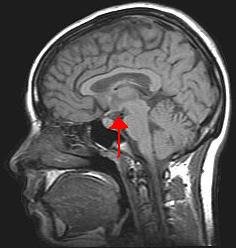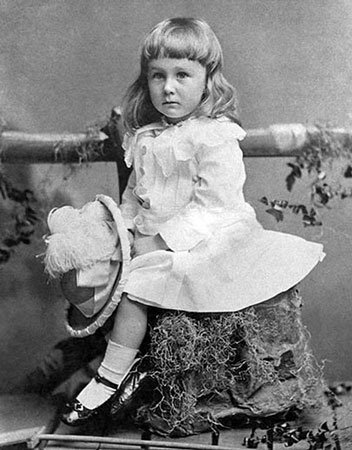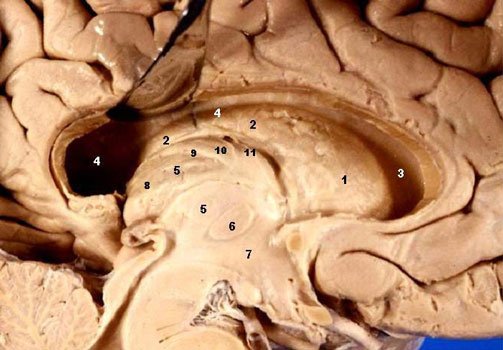Curtain Open

The hypothalamus, where most gender identity and gender orientation differences are found.
Source: Wikimedia commons w/ Public domain license.
I remember I used to be able to tell girls from boys long before I was able to tell penises from vaginas — heck, before I knew there was such a thing as a vagina! And even after I had realized that girls don't have the same parts as me, I still referred to the vagina as "the female penis". I lacked the linguistic term for it. No one had taught it to me. It made communication with older boys difficult. I distinctly remember a conversation I had with a friend who was a year older. I kept referring to women's vaginas as "the woman's penis", and he kept correcting me: "women don't have penises!" I said, "I know theirs are different from ours, that's why I'm calling them the woman's penis - duh!"
A sex differences researcher relates a comparable anecdote. She writes about one day when her son Jonathan decided to wear barrettes at nursery school. He was promptly ridiculed by another little boy, who insisted Jonathan must therefore be a girl. Jonathan — a true sex differences researcher's child — an egg that did not fall far from the chicken that laid it — explained that barrettes don't matter: he has a penis and testicles, and therefore he's a boy. That didn't convince the other boy, however. Finally having had enough of that — and presumably in keeping with the writer's dictum "show, don't tell" — Jonathan dropped his pants. The other boy looked on unimpressive as he said, "Everybody has a penis; only girls wear barrettes."[2]

Which is more manly, a barrette or a Beretta? Well, let's just say the Japanese Geishas used concealed hairpins as weapons. Anything can become a weapon in the hands of a skilled and determined warrior!
Source: Gerd Fahrenhorst w/ Attribution 3.0 Unported license & Leo Tante w/ Attribution-Share Alike 4.0 International license, modified.
The 7th element of a person's gender, according to John Money, is gender identity. It's the gender with which a person identifies. Most researchers agree that a child has formed his gender identity by age 3. That refers to the core of his gender identity: the fine points can continue to develop for decades — I'm in my thirties and I'm still refining my knowledge of gender, as these posts bear witness!
But, as the above two stories illustrate, even though a child has formed his gender identity by age 3, relating that to genitalia typically comes later.
Let's now take a closer look at some of the research that examines this.
Gender constancy

An awful image? The word awful used to mean worthy of awe. That's some lack of definitional constancy.
Source: NASA w/ Attribution 2.0 Generic license.
From that last story, there's three things we can deduce about the boy who said Jonathan is a girl. First, he didn't know sex is based on genitals. Second, he believed sex is based on one's looks, clothes, and behavior (we may call these "visually salient perceptual cues"[2]). Third, he (therefore?) believed that sex can easily change depending on these visual cues: changing your sex was as easy as putting on barrettes.
Because of no. 3, a child like Jonathan is said to lack what's called "gender constancy" or "gender permanence": the belief that gender persists across external permutations and is "not subject to spontaneous or willful change"[1]. "Gender constancy" is an unfortunate term, since what's meant by it is "sex constancy". But developmental psychologists are, like all humans, creatures of habit, so they still employ the familiar term.
How do psychologists measure gender constancy?

Source: Steven Depolo w/ Attribution 2.0 Generic license.
One way to measure gender constancy is to ask the child questions about itself. This measure was designed by Slaby and Frey and was appropriately called the Slaby-Frey measure. It involves asking the child the following 3 questions:
If you wore [opposite-sex] clothes, would you be a girl or a boy?
If you played [opposite-sex] games, would you be a girl or a boy?
Could you be a [opposite sex] if you wanted to be?
It's interesting how children are much more gender-constant when it comes to themselves:
as many as 40% of preschoolers are typically able to pass the Slaby-Frey measure of gender constancy but not other measures.[2]
Oh, so another child becomes a girl as soon as he wears barrettes, but when you do it your sex remains constant. Ever hear about double standards, little kid?

Source: Maxpixel w/ CC0 1.0 Universal license.
The second most popular way of measuring gender constancy is the Emmerich way. It involves presenting the child with a drawing of a boy or a girl, with stereotypical sex characteristics (say a dress and long hair for a girl). The drawing is introduced by the interviewer with something like, "This is Mary. Mary is a girl."
Underneath this top drawing hides another drawing with characteristics of the opposite sex. The top drawing is sectioned, so that you can remove a part of it and reveal something different underneath. So if the top picture shows a girl, the body from the neck down can be removed to reveal a body wearing pants. Or the hair part may be removed to reveal long hair underneath. And so the interviewer might ask the child something like, "If Mary cuts her hair short like this and wears boys' clothes like this, what would she be? Would she be a girl, or would she be a boy?"
Unsurprisingly, many more kids fail to pass this test than when their own masculinity or femininity is at stake. In the initial research by Emmerich, the oldest children, aged 7, only exhibited gender constancy 25% of the time. (Recall that for the Slaby-Frey test, it was 40%.) For the youngest children, aged 4, the figure was 7%. Studies done later using the Emmerich test reproduce these results.
As one who has taken classes in experimental philosophy, I was immediately dubious about the form the interview questions took. I'm not sure the children understood them. I'm not even sure all adults would understand them in the same way. If you draw me the figure of Batman, and then draw me another figure with a Batman that has boobs and long hair and a slender waist, and then ask me if Batman is now Batwoman, I'll likely reply that "yes, Batman is now Batwoman", just as I'd say "Batman is now armless" if you drew him without an arm.
(And it's not just the wording, but also the order. In one paper, a change of order in the questions yielded a 20% difference in the responses.[1])
These concerns about linguistic understanding are reflected in the literature:
Slaby and Frey clearly mean to ask, "If you temporarily put on crossgender clothes or temporarily played with cross-gender toys, would your sex be transformed in some very deep sense, or would it remain constant?" But the questions could also be interpreted by the child to mean, "Would you look like a girl or a boy?" or "Would you be pretending to be a girl or a boy?" or even "If you were the kind of child who regularly did [opposite-sex] things, probabilistically, is it likely that you would really be a girl or a boy?"[2]
Similarly for the Emmerich test:
the child could just as reasonably treat the original stimulus as nothing more than a schematic drawing that the interviewer has defined as male or female purely on the basis of its hairstyle and clothing, in which case the correct response is that, if the drawing's hairstyle and clothing have changed, then the drawing's sex has changed as well.[2]
Some researchers have tried to get around that by modifying the questions for the Slaby-Frey test. For instance asking, "If you wore [oppositesex] clothes, what would you really be, a boy or a girl?"
The addition of "really" really spiked the numbers: a full 95% of children responded to the question correctly.
But I'm still not convinced: it looks to me as though they're priming the child to give them the answer they want. The word "really" often prompts us to reevaluate our initial response, and emphasis often implies that the correct answer is whatever the questioner himself believes.
For the modified Emmerich version, studies took classmates of the children, dressed them up in opposite-sex clothes, took photographs, and then based the interview on those. Obviously, children gave kinder replies regarding the gender constancy of their classmates.
Except Jonathan's friend. He just pissed himself laughing when he saw Jonathan in a dress.
But seriously:
Although the subjects were only 3, 4, and 5 years old, virtually 100% responded correctly.[2]
It seems the children do believe in the gender constancy of people they came to know well.
(Beware of the moral here, in case you ever decide to work as a polster: framing the question right, can often give you whatever answer you want.)
But would the children answer the same for other children they didn't know? Is it really gender constancy the researchers were measuring, or habit? Maybe the child just got used to calling Mary a female, just like developmental psychologists got used to calling sex constancy gender constancy.
I, for one, am unconvinced and confused. I'm on the verge of feeling gender-dysphoric.
On what is pre-schoolers' gender constancy based on?

Source: Abilngeorge w/ Attribution-Share Alike 4.0 International license.
The perceptive reader will have noticed something interesting. Let's examine the following claims:
Pre-schoolers believe that sex is based not on immutable things like genitals, but on mutable things like behavior, looks, and clothes. We called these "visually salient perceptual cues".
Pre-schoolers believe that sex changes when these cues change. Barrettes = you're a girl.
Pre-schoolers, according to the modified Slaby and Frey and Emmerich experiments, have more gender constancy than was earlier thought.
The old researchers, with their unmodified experiments, believed in 1 & 2. This was consistent: children based their opinions about a person's sex on mutable things like looks and behavior (1) and so it's no wonder that children lacked gender constancy (2).
But the new researchers, with their modified experiments, seem to believe in 1 & 3. But how can we reconcile 1 & 3? If a child believes Mary is a girl because she has locks and wears a skirt, but then when you dress Mary like a boy the child still insists Mary is a girl, then what has just happened?
One way out of this is to say that pre-schoolers are morons. Moron being the modern Greek term for a child of preschool age. Let's just say that Piaget may have taken this path when he decided that before the age of 6 or 7, children are "characterized by several intrinsic limitations of thought"[2], and he called those the preoperational years. Hey, if you're gonna call someone stupid, you might as well do it in scientific lingo!
It was based on these observations that researchers decided to test children's gender constancy with real nudies.
Showing kid nudies to kids

Bacchus' picture is hung, in some museum.
Source: Jacques Jordaens w/ Public Domain license, modified.
The first study in the literature to probe the relation between children's biological knowledge of genitalia and their gender constancy was, obviously, a Swedish study. They did this by having the clothes on the bodies in the drawings be transparent, so that the genitals showed underneath and remained constant across clothing changes.
Despite this, the percentages the study got were quite low: only 23% of 7-year-olds and 0% of 4-year-olds exhibited gender constancy.
McConaghy's low percentages are striking because Swedish children are known to have much more biological knowledge about sex than American children (Goldman & Goldman, 1982).[2]
Oh, turns out I wasn't just blurting out a stereotype with my 'obviously' joke about the Swedes!
Not to be outdone by the sex-shrewd Swedes (hey, science allows me to say this!), the Americans decided to show the children real nude photos.
The real reason for that, obviously, was not competition, but to tackle the study's methodological shortcomings: the Swedish study still suffered from the linguistic problem, and the drawings, even though they showed the genitals, were still schematics. Coupling the "real photos" idea with the Swedes' "visible gens" idea was the natural next step.
Showing real kid nudies to kids
And so in order to probe kids' gender constancy as it relates to their knowledge of genital sex differences, what better way than to stimulate kids with full-color photos of toddlers in the nude, flowing wispy hair and everything:
The stimuli [...] were 8 x 10, full-length, color photographs of toddlers between the ages of 1 and 2. The toddlers were nude from at least the waist down and had wispy, babylike hair that did not demarcate sex.[2]
"Well, who needs to see you naked from the waist up anyway when you haven't developed breasts yet", Jonathan's friend is reported to have said.
And so the first photograph showed the toddler in the fully nude, the second photo showed them with opposite-sex ("gender-inconsistent") clothing and apparel, and the third showed them in regular ("gender-consistent") clothing. So, for example, in the gender-inconsistent version, boys were clad with "long ponytails with pink barrettes and a frilly pink blouse"[2].

If Franklin D. Roosevelt can dress like that and still become president, I don't see why commoners can't wear frilly pink blouses.
Source: Wikimedia w/ Public Domain license.
The results of the study showed that 40% of the 3- to 5-year-old children could conserve sex across perceptual transformations. But more importantly:
only those children who had domain-specific knowledge about both the genital difference between the sexes and the priority of genital cues over cultural cues were able to do so.[2]
The author concluded that:
conservation [...] requires both the knowledge of male and female genitalia and the knowledge that, whenever genital and cultural cues are in conflict, genital cues have priority in determining sex.[2]
But the word "requires" implies necessity. Is it is really so? Did absolutely no children pass the conservation test without having biological knowledge of genitals? The answer is no: some children passed the test without knowing anything about genitals. The researchers explained that away thusly:
Because these three children were all very young and had virtually no genital knowledge at all, it seems likely that they passed the conservation test by chance.[2]
Also, 26% of those who had the biological knowledge, didn't pass the conservation test.
I'm not saying this puts holes in the paper's argument, but I still think there's some "leading the witness" elements in the interview questions. Showing the child the naked photo first, asking it fully 4 questions, of increasing depth, about the child's sex, drills home the point that Mary, say, is a girl. Whatever questions are asked afterwards will be referred back to the initial impression that the child formed. And, as many business columns claim, first impressions matter!
It is also interesting, research-wise, that the 40% reported by this full-nude Toddlers-Gone-Wild study was the same as the initial number Slaby and Frey got with their very simple verbal tests, but higher than many of the (more involved) Emmerich tests. This tells me that failing or passing tests might be — brace yourselves for a controversial idea — a result of the difficulty of the tests?

Source: OpenClipart-Vectors w/ CC0 Creative Commons license.
Another interesting finding was that "the seven youngest conservers were all girls"[2], and that in males genital knowledge increased with age, whereas 3-year-old girls had the same genital knowledge as 5-year-old girls and boys.
preschool boys appear to know strikingly little about opposite-sex genitalia[2]
The author of the study didn't know what to make of this, but she offered the hypothesis that it may be because boys' genitals are more pronounced and more visible in the media, so that a girl will learn that her parts are different from half the population very early on. This is bolstered by the fact that only 15% of boys used the term "vagina", as opposed to almost 60% of girls, whereas both girls and boys used the term "penis" almost equally. To this author's chagrin, there was no indication of anyone using the term "female penis". But equally funny terms were used, like tinkle, z-z, peepee, tail, tushi, and peanuts for penises; and ginny, asty, crack, and hynee for vaginas.
Of interest are also the children who passed the self-measure but failed the other-measure with flying colors:
These eight subjects all seemed to be quite sure that they themselves were, always had been, and always would be either boys or girls. [...] At the same time, however, six of the eight could not manage to pass even one subtest of the genital knowledge test, which means that they could not tell which of two babies was a boy and which was a girl even
when the two babies were totally nude and pictured side by side.[2]
The author of the study adds:
Children like these suggest that-my emphasis on genital knowledge notwithstanding-there may well be more than one way for a child to understand sexual invariance.[2]
And that, I believe, is the take-home message from this research. I too think that children, despite not knowing about genitals, think there's some other X factor that determines whether or not you're a boy or a girl. They were familiar with this X factor in their own cases because of the access they have to their own thoughts and feelings, but were unfamiliar with this X factor when it came to other people. This X factor may well be the brain.
And that brings us to the second part of this post: absent of genitals, what is a child, a boy or a girl? If sex depends on the genitals, and the genitals are ambiguous, then all that's left is socialization, and so socializing ambiguous children as a specific sex should grant them a gender self-identity fitting that sex.
If only.
Botched phimosis repair

Source: PublicDomainPictures w/ CC0 Creative Commons license.
A botched phimosis repair must be right up there with botched circumcision in the list of things you'd never wish on your worst underage enemy.
A phimosis is the medical condition whereby the penis foreskin cannot be pulled back from the penis head. A phimosis repair is when cauterization is used to fix the problem. A botched phimosis repair is when your penis feels like someone just lit it on fire. The reason it feels that way is because that's what happens. And I don't just mean that theoretically:
During a phimosis repair by cautery at eight months of age, his penis was accidentally burned beyond repair.[3]
"His" is an XY individual and identical twin who wished to remain anonymous in the paper. Based on the consul of consultants who held the then current — but now hopefully antiquated — assumption that "individuals are psychosexually neutral at birth"[3], the child was henceforth raised as a girl and had sex reassignment surgery done to him 9 months later to make things physically official. What was initially an accident was now done with purposeful relish, as orchiectomy (removal of peanuts) and the construction of a vulva were performed, probably by Antonio Banderas after he got a taste for it in The Skin I live In.

The monsters behind The Skin I live In, a must-see for Oldboy and Incendies aficionados.
Source: Georges Biard w/ Attribution-Share Alike 3.0 Unported license.
John (as he was pseudonymed in the papers that discussed his case) did not feel like a Jane. He associated with boys, did boy things, had boy interests, and shunned the interests and activities of girls. Through lips rounded by hormone therapy, and beating his breast that was female because of the estrogen, he insisted he was a boy. Despite no memory of sex reassignment, he:
suspected I was a boy since the second grade[3]
John, understandably, contemplated suicide.
Not long after he turned 14, the clinical team and his family discussed John's wishes to live as a boy, gave in to them, and revealed to him his history. This came as a relief, as it confirmed everything John knew about who he really was.
John subsequently made up for all his lost years of not courting females and rejecting advances by douchebags. He got married at 25 and adopted his wife's children. John's parents were racked by guilt, but they make up for it by throwing rocks at people who say that "gender is 100% socially constructed" [reference pending].
Nipping gender identity in the bud?

Source: Pixnio w/ Public domain license.
John was clearly a boy, born with a normal penis, so he wasn't exactly an ambiguous case. Perhaps a truly ambiguous case, like a hermaphrodite, will prove that gender identity is the result of socialization?
Pseudonymous Samantha (a name that can conveniently be collapsed to gender-neutral "Sam") was pronounced a girl at birth and raised as such. A "phallic bud" was noticed at the age of 5, but to Samantha's ardently religious mother, things specifically phallic or generally genital were to be ignored, not attended to:
"Nice girls don't look at or play with themselves."[3]
But as Samantha grew, she noticed she wasn't like other girls:
"As I grew up I increasingly felt I had a boyish male drive and frame of mind when I compared my way of thinking about things to the way I saw my girl friends and boy friends think."[3]
Too bad there wasn't someone there to inform Samantha that she was being sexist, talking like that about "male drive[s] and frame[s] of mind".
When adults talked behind her back (incompetently, apparently) about their suspicion that Samantha might grow up to be a lesbian, she thought that didn't really describe her, since, even though she felt like a man, she was definitely attracted to men. Basically, she felt like a homosexual man, not a lesbian.
As years went by, a series of doctors paid very little attention to her concerns. When her periods were late, a doctor described her as a late bloomer. Her increasing virulization and hirsuitism were ignored. At age 15 she was shaving. (This is normal for Mediterranean girls where I come from, but for girls from other parts of the world it's not uncommon to start growing hair in their mid twenties.) Tests to find out what was wrong with her "would cost about $500.00 and not be worth it"[3]. The doctor, again without physical examination or discussion, prescribed pills that would stimulate breast growth and menstruation, and thus her menarche began. Samantha was disgusted by all this:
"The whole process didn't seem right for me although I couldn't say why."[3]
In her teens, Samantha overcompensated for her lack of femininity. She entered a "beauty, talent, and scholastic achievement contest" and won it, relieved that there was no bathing suit competition. She was crowned Junior Miss of her community, and no doubt many males pined for her.
But as puberty demanded its heavy toll, a drop in voice register and increased hirsuitism were increasingly harder to hide.
"Gradually," Sam recalled, "I looked like a caricature of a female; it was a counterfeit image that worsened with time."[3]
In what appears to be a theme in these kinds of situations, Samantha contemplated suicide.
At 18 she had her first sexual experience with another person: a male partner. Intercourse proceeded as normal and there was nothing out of the ordinary mentioned by the partner.
At 23, Samantha left home, and her newfound independence allowed her to pursue her case more diligently. She went for a full medical evaluation, which revealed that she was "a 46, XX true hermaphrodite with androgen-secreting polycystic ova-testes and some cellular mosaicism."[3]
Without any discussion, presumably assuming Samantha desired to remain a female, the doctors prescribed a new regimen of estrogens. There was no advice, no suggestions for further consultation, no follow up. She:
left the hospital "miserable and depressed." Samantha did not think she had any options but to continue living in this limbo.[3]
It was only in her late 40s that Samantha, talking to a friendly counselor, broached the possibility of her living as a man. It was something she strongly felt but never seriously considered before. A nudge was all it took:
"After years spent wandering in an emotional quagmire and living an agonizing lie I made the mammoth switch to becoming a man. I did it cold turkey, almost overnight. I just stopped taking the estrogens and let my beard grow in. I immediately gave away everything that was female. And I never looked back. I never again put on lipstick, wig or dress in public or private. And when I got my brand new male birth certificate from the court [after prolonged legal wrangling] it was the happiest moment of my life. Now I don't think of how to behave. My maleness just comes naturally. I feel the brotherhood with men that I never felt with females. [...] as I look back it's like I was on a scenic detour as a female and finally found the main road leading to my real life."[3]
Samantha became Sam. And though he's bisexual, he feels no ambivalence in identifying as a male. (Straight readers might associate gender identity with sexual orientation, but one has nothing to do with the other, and being bisexual does not mean you are 'confused'.) His mother still calls him "daughter" and refers to him by her old name, but his father has accepted the change. Sam is a successful professional and he devotes a healthy amount of his time educating people about hermaphroditism and intersexuality.

Hijras have long been recognized as a third gender in India.
Source: USAID w/ Public Domain license.
The two stories above put a sufficient dent in the idea that gender identity is the result of socialization or of having male or female genitals. In the first case (botched phimosis repair) the genitals were tacked away quite radically, and John was raised as a girl. In the second case there was true hermaphrodism (female + male parts), the mental coin flip decided she would be raised as a girl, and so Sam was given estrogen to hide all other external signs of maleness. Still, both John and Sam felt strongly and from the get-go that they were males. They rejected the labels society (family, doctors, and friends) hung around their neck and what they saw or didn't see between their legs didn't matter either. It seems there's something more to gender than just genitals and socialization. In John's and Sam's case, it seems it was something from within. Those of you who followed my previous posts on hormones and brains, know where this is headed.

Source: vvaniasantoss w/ CC0 Creative Commons license.
But before we move on, don't think John and Sam are just two rogue cases. The medical literature is littered with similar examples. Of an African boy whose genitals were removed by marauders and who was then raised as a girl, whose parents said "[w]e have tried to treat him like a girl, but he does not want to accept it"[3], and who asked his parents why he can't relieve himself like other boys; of a boy born with hypospadias (a urethral opening along the shaft of the penis), leading the midwife to pronounce him a female, and who "[i]n all his dreams and day dreams [...] he had appeared as a man or a boy, never as a girl"[3]; of a 14-year-old female who went to a clinic asking to be examined, as she believed herself to be a boy, and even though she had all the externals of a female, had no breast development, had no menstruation, still medical examination revealed to be "a 46, XY male"[3]; and so on.
"Prenatal hormonal effects may be more important to gender identity than previously realized"[3]
Thus concluded Reiner and Meyer-Bahlburg (1995), reporting on 4 cases of 46, XY males with severe genital anomalies who were reassigned as females, and who insisted they were boys despite all social pressures to the contrary.
And that's not even counting the dozens of cases of males who suffered from gene and enzymatic defects in their androgen synthesis, leading to incomplete male genitalia, who were raised as girls and yet "almost all switched to living as males".
All these cases provide reason enough to challenge critically the role of rearing in one's sexual identity[3]
Unlike the kids we saw in the first half of this post, who grounded their sexual identity in how they were treated by others and how they and their genitals looked, most of the cases in this section show people who are raised as the opposite sex, lack normal genitalia, and yet are quite convinced that they don't belong to the sex they were assigned to. And medicine proves them right: they are either definitively not the sex they were initially assigned, or they are ambiguous.
So how did these kids know? Where did all that conviction come from?
The posteromedial bed nucleus of the stria terminalis

No. 11 is the stria terminalis.
Source: John A Beal, PhD Dep't. of Cellular Biology & Anatomy, Louisiana State University Health Sciences Center Shreveport w/ Attribution 2.5 Generic license.
The what of the what now? Don't worry, you'll get the gist of it, if not the hang of it, by the end of this section.
The BNST (bed nucleus of the stria terminalis) shows sex dimorphism (=difference between males and females excluding sex organs) in several rodent species. In lab animals, a specific subarea (called BNST-dspm) of the BNST appeared to:
exhibit[...] volumetric [...] sex differences[4]
exhibit[...] neurochemical sex differences[4]
concentrate gonadal hormones more heavily than other regions of the BNST[4]
is connected anatomically to other sexually dimorphic nuclei[4]
So scientists decided to examine the same area in the brains of humans. They went to a brain bank and selected brains from 26 human subjects. These brains were age-matched, did not show any evidence of neuropathology, were removed from the skulls of their owners within a 24 hour period after death, and promptly placed into a fixative (formalin).
After rigorous preparing and manipulating and staining and measuring and mathematically analyzing, the results came out as follows:
The volume of the BNST-dspm was significantly greater in males than in females[4]
And how much is significantly?
The left [...] BNST-dspm was 2.50 times greater [...], whereas the right was 2.44 times greater [...] in males than in females.[4]
This wasn't an artifact of brain size:
The brain weight of males [...] was only 13.0% greater than that of females [...], in contrast to the volume of the BNST-dspm, which was 147% greater in males than females[4]
Regarding the BNST's function, what we know comes mostly from other animals:
Electrical stimulation of the BNST modulates aggressive behavior in cats [...] and corticosterone secretion in rats [...] play[s] an important role in behavioral and neuroendocrine aspects of reproduction[4]
Furthermore, making lesions in this area decreases copulation activity in male rats. In female rats, chemical and electrical stimulation of the area influences ovulation and gonadotropin secretion.
These are all of course artificial ways of influencing the BNST. But there's also natural ways to influence brains and behaviors, like for example the stress a rat mother might feel during pregnancy, which feminizes and demasculinizes the behavior of the kittens[4] (yes, kittens is an acceptable variant of pubs when referring to rat offspring). So the gender identity of humans might be influenced, unintentionally, in comparable ways.
Do transsexuals have opposite-sex brains?

God/Goddess Shiva depicted in dual gender form.
Copyrighted to Himalayan Academy Publications, Kapaa, Kauai, Hawaii. Licensed for Wikipedia under Creative Commons and requires attribution when reproduced.
Looking at the genitals of transsexuals for an explanation of their predicament will, obviously, lead you nowhere. The same has been true for their genes, gonads, and hormones. So the hypothesis was introduced that maybe the brains of transsexuals, for whatever reason, don't follow the sexual differentiation that the rest of the body underwent, leading to that intense conviction transsexuals have from childhood of having been born in the wrong body.
But where in the brain does one look? Although there are no transsexual rats and monkeys don't sign-talk about their gender identity, still research like the one explored in the previous section led to the idea that the hypothalamus, and specifically the BNST, is the place to look.
A paper published in Nature looked at the BNST of male-to-female transsexuals, and found it to be female-sized.
It's size was only 52% of that found in the reference males[6]
Possible confounding explanations were dispensed with: Was the difference due to the transsexual individuals' estrogen treatment? Evidence from transsexuals who stopped taking their estrogens because of health conditions said otherwise. Was the difference due, not to the presence of estrogen, but the lack of androgens, since the transsexual individuals had undergone orchidectomy (acorn removal)? The researchers studied the brains of two men who also underwent orchidectomy because of prostate cancer, and their BNST sizes were in the high end of the normal male range; also, the BNST of a transsexual who had not been orchidectomized was in the middle of the transsexual range.
Interestingly, there was no difference in the BNST when it came to the sexual orientation of the transsexual individuals: it didn't matter whether they were male-oriented or female-oriented or both — apparently all that mattered was whether they considered themselves to be the opposite sex deep down.
Another study that went over several earlier findings relating to the sexual dimorphism of certain hypothalamic areas, as well as conducting its own study on the brains of homosexual men vs straight men (and finding that the suprachiasmatic nucleus of the former contains about twice as many cells as that of the latter) reported that:
In conclusion: differences in size and cell number have been reported in a number of hypothalamic nuclei in relation to sexual orientation and gender identity.[5]
Curtain Close

Sawed-off shotgun.
Source: I, Bluedog w/ Attribution-Share Alike 3.0 Unported license.
John/Joan, the botched phimosis repair victim, is now known to be David Reimer. His case famously discredits John Money's idea that gender identity is malleable and determined wholly or primarily by socialization. Socialization of course plays a role, but it's definitely not the whole story, and from what we now know it's not even the chunk of it.
Perhaps Money was too eager to reassign the sex of someone who was an identical twin, as the other boy would function as an ideal control, and would provide an excellent test case for his theories.[7] It was through the work of sexologist Milton Diamond, that was explored in this post, that the negative aspects of David's case came to international attention. Things were fine at the time of the article explored here, and David was seemingly happily married.
In the 2000s, aged 38, unemployed, after his twin brother died from overdose of antidepressants, and after his wife separated him, David committed suicide. Not a very positive 'curtain close' this time. The suicide was done with a sawed-off shotgun — was the choice of weapon an unintentional metaphor for what the doctors did to him? The whole David Reimer case was a debacle that cast a very negative light on an otherwise shining reputation and achievements of John Money. More about the case can be read here.
John Money's ideas about the malleability of gender were dominant, until Reimer's case and those of others were brought to light, and put the "biology" back into "biology of gender". Sexual reassignment became a much less popular option, and hopefully this post will have shed some light on why that is. There are more biological things in sex and gender than are dreamt of in social constructionist philosophy:
There is no documented case where a typical male has accepted assigned life as an androphilic woman despite such rearing nor a case of a typical female accepting imposed life as a gynecophilic man.[3]
So much for socialization.
See you next time!
REFERENCES
McConaghy, M. (1979). Gender Permanence and the Genital Basis of Gender: Stages in the Development of Constancy of Gender Identity. Child Development, [online] 50(4), pp.1223-1226. Available at: http://www.jstor.org/stable/1129354.
Bem, S. (1989). Genital Knowledge and Gender Constancy in Preschool Children. Child Development, [online] 60(3), pp.649-662. Available at: http://www.jstor.org/stable/1130730.
Diamond, M. (1997). Sexual identity and sexual orientation in children with traumatized or ambiguous genitalia. Journal of Sex Research, [online] 34(2), pp.199-211. Available at: https://doi.org/10.1080/00224499709551885.
Allen, L. and Gorski, R. (1990). Sex difference in the bed nucleus of the stria terminalis of the human brain. The Journal of Comparative Neurology, [online] 302(4), pp.697-706. Available at: https://doi.org/10.1002/cne.903020402.
Swaab, D., Gooren, L. and Hofman, M. (1995). Brain Research, Gender and Sexual Orientation. Journal of Homosexuality, [online] 28(3-4), pp.283-301. Available at: https://doi.org/10.1300/J082v28n03_07.
Zhou, J., Hofman, M., Gooren, L. and Swaab, D. (1995). A sex difference in the human brain and its relation to transsexuality. Nature, [online] 378(6552), pp.68-70. Available at: https://doi.org/10.1038/378068a0.
Wikipedia contributors, "David Reimer," Wikipedia, The Free Encyclopedia, https://en.wikipedia.org/w/index.php?title=David_Reimer&oldid=846837788 (accessed June 27, 2018).
Wikipedia contributors, "Gender identity," Wikipedia, The Free Encyclopedia, https://en.wikipedia.org/w/index.php?title=Gender_identity&oldid=847230765 (accessed June 27, 2018).
Mealey, L. (2000). Sex Differences: Developmental and Evolutionary Strategies. 1st ed. Academic Press. Available online at: https://doi.org/10.1016/B978-0-12-487460-2.X5000-4
Earlier Sex Differences episodes:
7: Do Parents Stereotype Their Children's Gender?
6: Sex Differences: Do females and males have different brains? Addendum
5: Sex Differences: Do females and males have different brains? Pt 3
4: Sex Differences: Do females and males have different brains? Pt 2
3: Sex Differences: Do females and males have different brains?
2: Sex Differences: Check out the gonads on that one!
1: Sex Differences: Does the Chromosome Maketh the Man?
steemSTEM is the go-to place for science on Steemit. Check it out at @steemstem or browse the #steemSTEM tag or chat live on discord
